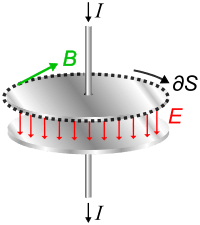Physics equations/24-Electromagnetic Waves
< Physics equations- Q:displacementCurrent: The fourth problem is tedious:
Problem

A circlular capactitor of radius 3.3 m has a gap of 12 mm, and a charge of 93 μC. The capacitor is discharged through a 9 kΩ resistor. What is what is the maximum magnetic field at the edge of the capacitor?
Though this is a tedious problem, it is significant because it can be solved with basic equations, and because it shows why Maxwell inserted the displacement term in the integral form of Maxwell's equations for magnetic field:
Define:
 to be the enclosed charge
to be the enclosed charge to be the enclosed charge.
to be the enclosed charge. as the vacuum permittivity.
as the vacuum permittivity. as the magnetic permeability.
as the magnetic permeability.
To under stand Maxwell's term, note that if the surface is taken inside the capacitor, it is enclosing electric field. But from Gauss's Law, we know that the electric field is directly proportional to charge. We need a term proportional to current, which is the time-derivative of charge. To recover Maxwell's term, we
Deriving Maxwell's term
We start by assuming that the current could either be an actual current or a term corresponding to what the current would be if there were no capacitor. We denote this current with a tilde, and  is called the displacement current.
is called the displacement current.
(1) 
The electric field,  , is related to
, is related to  by Gauss' law
by Gauss' law
(2) 
For a parallel plate capacitor:
(3) 
Taking the time derivative,
(3) 
Substituting into (1):
(4) 
For our geometry, the electric field is constant over the surface of the capacitor. Hence we can convert to a surface integral:
(5) 
Substituting yields our result:
(6) 
